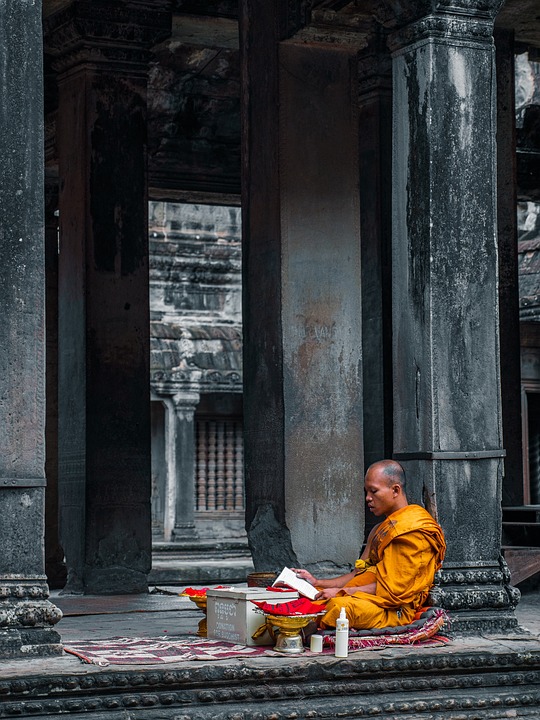
During the time of the 3 Kingdom States, Buddhism entered first the Koguryo Kingdom in the North, in 372, the Paekche Kingdom in 384, and the Southeast Kingdom of Silla in 527. During the unified Silla period 676-935 Buddhism was the unifying force that united the people into a nation.
When giving expression to the Korean spirit we often hear that mentally Koreans are Confucian, but in their hearts Buddhists. The reason according to the writer was during the Chosen period from 1392-1910 the kingdom followed the policy of down with Buddhism and up with Confucianism. The relationship that the head has with the heart is no easy matter to fathom.
When we look at the situation with any depth we have the world of the Shamans who were in Korea centuries before Siddhartha Gautama and Confucius arrived. Did the world of the male and female shamans disappear after the entrance of Confucianism and Buddhism?
An important reason that Buddhism lost the influence it had during its golden age was not only its attachment to the ruling elite but also its close connections to the shamans in society. At the end of the Japanese occupation 1910-1945 this all ended.
President Syngman Rhee (1948-1960) a devout Methodist was the the president after liberation. He considered Zhu Xi (1130-1200) philosopher and politician during the Song Dynasty influential in the development of Neo-Confucianism. Syngman Rhee considered Neo Confucianism the reason for the problems in Korea and Buddhism the pro Japanese faction.
Buddhism towards the end of the Chosen Dynasty was connected with Japanese Buddhism and was seeing a revival.The government leaders of Japan in order to weaken the influence of Confucianism tried to strengthen Buddhism. President Rhee did the opposite and tried to weaken Buddhism and sided with the Buddhist nuns who were only 5% against the married monks who numbered over 95 %. President Park Chung-hee (1963-1979) separated the Buddhist into the celibate which became the Jogye Order and the Taego Order which had both the married and unmarried. The nuns were all unmarried which settled the issue for Buddhism.
In the 1960s Buddhism had another competitor in Christianity. And since Syngman Rhee was a Christian he gave the green light to Christianity and saw it as a great help for the future of Korea. However the essence of the Bible is Luke 10:27—You must love the Lord your God with your whole heart, your whole soul,your whole strength,and your whole mind, and your neighbor as you do yourself— How do these come to exist together in Korea, a multi-religious cultural sphere ruled by shamanism deep down, Buddhism in the heart, and Confucianism in the head?
Not a small number of Christians when faced with adversity will end up going to the temple or the Shaman. What would be the reason for this? The writer a specialist in Buddhism frequently goes to the temples and meets many who have left their Catholicism. Some have told him that whether it's Buddhism or Catholicism it is all the same and there is no reason to be concerned. There is no problem with the nobility of Buddhism and its teaching but they are not the same. When one tries to make them the same it is either a lack of knowledge or a failure to look deeply into the situation, they fail to see the contradictions.
In a serious examination of Buddhism we have reincarnation and purgatory, mercy and love, Buddhist emancipation and resurrection, Nirvana and heaven. Very difficult to make them the same.
There are many different sects of Buddhism in Korea. It is best to see Buddhism as a plurality of beliefs. Consequently to see what the essence of Buddhism is we have to go back to the beginning. However, according to many going back to the beginning to Siddhartha Gautama (563? 483?)we know three things: he was born, lived and died. In the past decades the Buddhist scholars were sure that Sakyamuni was not a myth but an historical person however in recent times some scholars are wondering whether this is the reality.
In Korea to be recognized as a Buddhist group there are certain requisites: it all began with Siddhartha Gautama. Sakyamuni first taught the Four Noble Truths and the Eightfold Path to the monks he met after he attained enlightenment.
The Four Noble Truths are traditionally identified as the first teaching given by the Buddha after he attained enlightenment.The truth of suffering, all forms of existence are unsatisfactory. The origin of suffering arises from craving, or attachment conditioned by ignorance. The cessation of suffering accomplished by the renunciation of desire or attachment which is also called nirvana the ultimate goal.The path to the cessation of suffering which is the Noble Eight-fold Path: right view, right intention, right speech, right action, right livelihood,right effort right mindfulness and right concentration.
There is no mention of a personal relationship with the Buddha. Since Buddhism is a non-theistic teaching, it is meaningless to have a personal relationship with the founder, Buddha. In other words the enlightenment is the essence of the teaching. Sakyamuni is only a figure who teaches the way to liberation from life and death as an example of enlightenment.
At the time of his baptism, Jesus realized in the Holy Spirit that he was the son favored by his father, the Lord. If you read the New Testament to the end, Jesus came to show us the way to the Father and to overcome death and enter eternal life. He was the way, the truth and life. We try to become one with him. This is what he taught us and what we hear from the Church today. "A disciple is not higher than a teacher. However, anyone who learns will become like a teacher" (Luke 6:40).
No comments:
Post a Comment